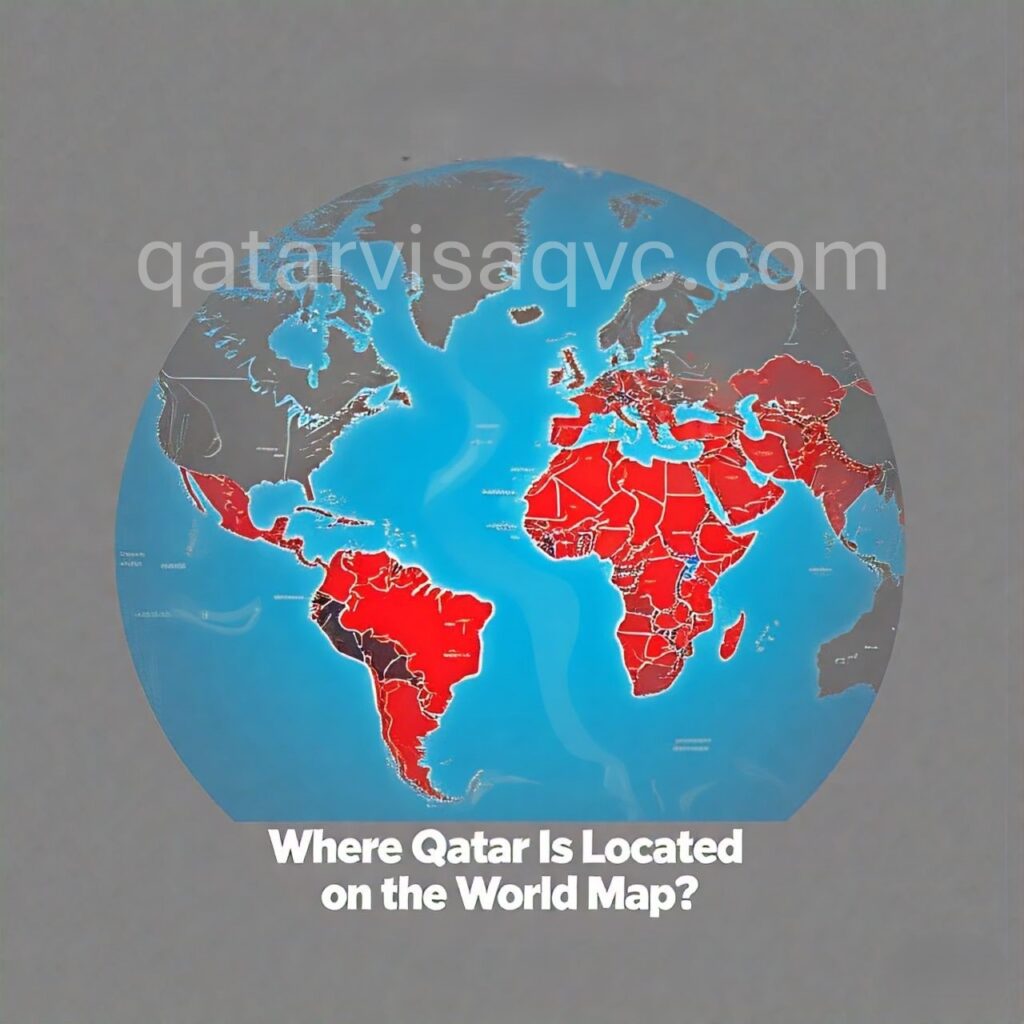Qatar, though small in size, holds a significant place on the global map. Its location in the Middle East makes it a focal point for energy, trade, and global events.
Introduction
Imagine a small yet influential country nestled in the heart of the Arabian Peninsula, playing a crucial role in global energy, trade, and international relations. That country is Qatar. Despite its small size, Qatar has made a big name for itself on the world stage. Whether you’re a geography enthusiast, a traveler, or someone curious about the Middle East, understanding where Qatar is located on the world map provides valuable insights into its significance.
In this article, I’ll guide you through the exact geographical position of Qatar, its borders, and why its location is so important. By the end, you’ll be able to pinpoint Qatar easily on a map and understand its role in connecting the East and the West. Let’s dive in!
Understanding Qatar’s Location
Qatar’s geographic position on the Arabian Peninsula is unique and strategic. Surrounded by the Persian Gulf, it shares a land border only with Saudi Arabia.
Geographic Position
Qatar is located in the Middle East, on the northeastern coast of the Arabian Peninsula. It’s a small country, but its strategic location makes it highly significant. Geographically, Qatar is a peninsular nation, which means it is almost entirely surrounded by water, except for one land border. Its exact coordinates are approximately 25.3548° North latitude and 51.1839° East longitude, placing it firmly within the arid desert climate of the region.
Bordering Entities
Qatar shares its only land border with Saudi Arabia to the south, a key connection to the rest of the Arabian Peninsula. To the north, east, and west, Qatar is surrounded by the Persian Gulf, giving it extensive access to the sea. Across the Gulf to the east, it is relatively close to Iran, while to the west lies the island nation of Bahrain.
Proximity to Major Cities
Qatar’s capital city, Doha, is a central hub for business, culture, and travel. Its location in the Gulf region also places it near significant cities like Dubai in the United Arab Emirates (UAE), Riyadh in Saudi Arabia, and Manama in Bahrain. This proximity enhances its importance as a regional connection point.
The Role of Qatar’s Location
Qatar’s location strengthens its global influence in energy, trade, and diplomacy. Its geographic placement connects East and West, making it a vital international hub.
Strategic Importance
Qatar’s position in the Arabian Peninsula and its coastline along the Persian Gulf give it a strategic edge in global affairs. The country is one of the world’s largest exporters of liquefied natural gas (LNG), making its location vital for energy transportation to Asia, Europe, and beyond. Its geographical proximity to major oil-producing regions further strengthens its role as an energy powerhouse.
Hosting international events like the FIFA World Cup 2022 highlights Qatar’s efforts to leverage its location to attract global attention. With easy access to major shipping routes in the Gulf, Qatar plays a pivotal role in connecting Eastern markets with Western economies.
Trade and Travel Hub
Qatar’s location has made it a hub for international trade and travel. Hamad International Airport, one of the busiest in the world, connects travelers from Asia, Africa, and Europe, turning Qatar into a global crossroads. Similarly, the country’s extensive coastline provides access to key maritime routes, allowing efficient movement of goods across the Gulf and beyond.
Diplomatic Positioning
Geographically, Qatar’s location enables it to maintain close ties with regional powers like Saudi Arabia, Iran, and the United Arab Emirates, while also engaging with global powers such as the United States and China. Its location in a politically sensitive area has helped it develop a robust diplomatic presence, often mediating in regional conflicts.
Qatar’s geographic positioning isn’t just about where it sits on the map—it’s about how the country uses its location to influence trade, diplomacy, and global events. This strategic placement makes it a key player on the world stage.
Visualizing Qatar on the Map
Spotting Qatar on the world map is simple when you know its regional landmarks. Its small size and distinct position on the Arabian Peninsula make it easy to identify.
Spotting Qatar on the World Map
Finding Qatar on a world map is easy when you know where to look. Start by focusing on the Middle East region. Locate the Arabian Peninsula, a large landmass in Western Asia, bordered by the Persian Gulf to the northeast. Qatar is a small peninsula that juts out into the Persian Gulf, almost like a thumb sticking out from the larger Arabian Peninsula. Its unique position makes it stand out despite its relatively small size.
Nearby Countries and Water Bodies
- Saudi Arabia lies directly to Qatar’s south, forming its only land border.
- To the north, east, and west, you’ll find the Persian Gulf, a major waterway crucial for global shipping and energy exports.
- Nearby, you can spot Bahrain, a small island nation to Qatar’s northwest, and Iran, located across the Gulf to the northeast.
Identifying Landmarks and Cities
On a closer view, you’ll see Qatar’s capital city, Doha, prominently marked on the map. As the country’s largest city and economic hub, Doha serves as a key reference point for locating Qatar. Another landmark to note is the Gulf of Bahrain, which borders Qatar on the west, further enhancing its geographic visibility.
Tips for Easy Identification
If you’re looking at a world map, Qatar may appear small compared to its neighbors. To find it quickly:
- Locate the Arabian Peninsula.
- Focus on the northeastern part near the Persian Gulf.
- Look for the small protrusion of land into the Gulf—that’s Qatar.
By understanding these visual cues, you’ll never have trouble identifying Qatar on a map, even at a glance. Its size may be small, but its location is unmistakably significant.
Fun Facts About Qatar’s Geography
Qatar’s geography, though compact, is rich with unique features. From its wealth-driven economy to its desert coastline, Qatar offers surprising contrasts.
A Wealthy Nation with a Small Footprint
Despite its small size, Qatar is one of the wealthiest countries in the world per capita. This wealth is largely due to its vast reserves of natural gas and oil, which are exported globally. Its geographical position near major markets in Asia and Europe has played a significant role in this economic success.
A Desert Peninsula
Qatar’s geography is dominated by arid desert plains, with no major rivers, forests, or mountains. The country’s flat terrain makes it unique, as it seamlessly blends the sandy desert with its stunning coastline along the Persian Gulf. This landscape offers breathtaking views of dunes meeting the sea, making it a destination for both nature enthusiasts and adventure seekers.
Peninsular Nation
Qatar’s location as a peninsular nation is rare. It is surrounded by the Persian Gulf on three sides, which not only defines its geography but also boosts its maritime importance. Its coastline is dotted with beaches, ports, and fishing villages, adding to its cultural and economic identity.
Small but Mighty
Qatar is one of the smallest countries in the Middle East, with an area of just 11,571 square kilometers (4,468 square miles). To put this into perspective, it is smaller than many cities worldwide. However, its influence far exceeds its size due to its strategic location and wealth.
Unique Climate and Wildlife
The country experiences a desert climate, characterized by hot summers and mild winters. While its harsh environment may seem challenging, Qatar is home to a surprising range of wildlife, including desert foxes, falcons, and even marine species like dolphins, thanks to its proximity to the Persian Gulf.
These fun facts highlight how Qatar’s geography, though modest in scale, contributes significantly to its global prominence and unique charm. From its desert landscapes to its coastal beauty, Qatar proves that small nations can make a big impact.
Conclusion
Qatar may be small in size, but its strategic location on the northeastern coast of the Arabian Peninsula makes it a country of immense importance. Nestled in the Middle East and surrounded by the Persian Gulf, Qatar’s geography enables it to play a vital role in energy exports, international trade, and global diplomacy. Its unique position as a peninsular nation and its proximity to key regions like Asia, Europe, and Africa amplify its significance on the world map.
Understanding where Qatar is located on the world map not only enhances our knowledge of geography but also highlights the impact of its location on global affairs. Next time you see a map of the Middle East, take a moment to spot this dynamic country and appreciate its role as a connector of worlds.
Whether you’re a student, traveler, or just curious about global geography, knowing Qatar’s location helps you better understand its cultural, economic, and political importance. Qatar proves that even the smallest nations can hold the greatest influence.
FAQs
1. Where is Qatar located on the world map?
Qatar is in the Middle East, situated on the northeastern coast of the Arabian Peninsula, surrounded by the Persian Gulf and sharing a land border with Saudi Arabia.
2. What countries border Qatar?
Qatar shares its only land border with Saudi Arabia to the south, while the Persian Gulf surrounds it on the other three sides.
3. Is Qatar a part of the UAE?
No, Qatar is an independent country. While it is geographically close to the UAE, they are separate nations in the Arabian Peninsula.
4. How do I find Qatar on a map?
Look at the Arabian Peninsula in the Middle East and locate the small peninsula extending into the Persian Gulf—that’s Qatar.
5. Why is Qatar’s location important?
Qatar’s location is significant for global energy exports, its role in international trade, and its proximity to key global regions like Asia, Europe, and Africa.

